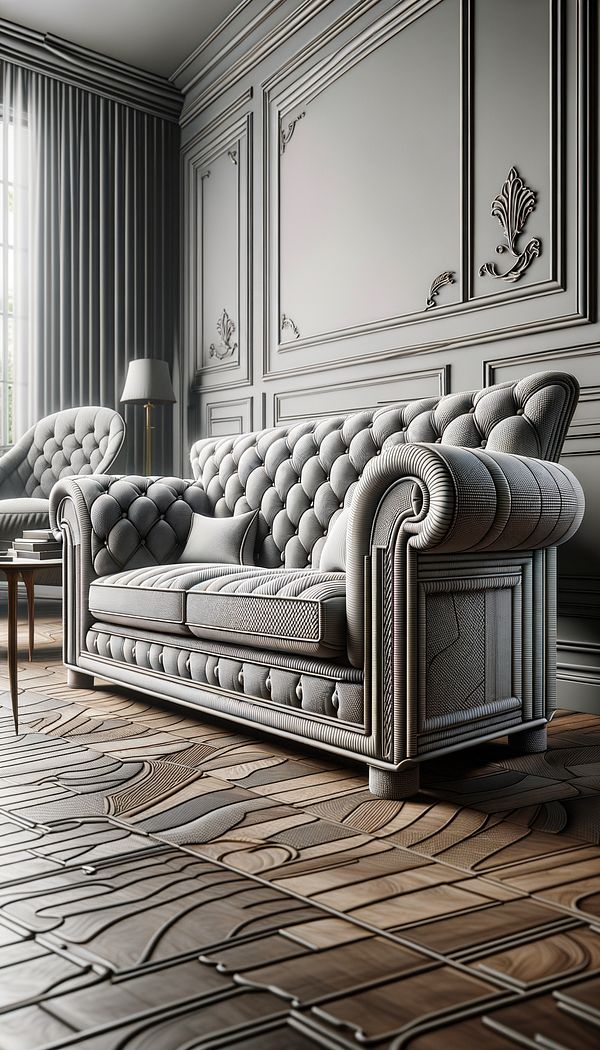What is Tailored Upholstery?
Tailored upholstery refers to furniture coverings that are custom-fitted and meticulously crafted for a neat, polished appearance.
Description
Tailored upholstery is a hallmark of quality and attention to detail in furniture design. This term encompasses a variety of practices and techniques used to achieve a precise, crisp look in upholstered furniture. It involves the careful selection of materials and textiles, including fabrics and leathers, and the application of methods such as precise cutting, sewing, and fitting of these materials to furniture frames. The goal is to create a tightly fitted, seamless covering that enhances the furniture's aesthetic and functional appeal.
The process of creating tailored upholstery begins with the meticulous measurement of the furniture piece to ensure that the cover fits perfectly. Skilled craftsmen then cut and sew the fabric, paying close attention to the alignment of patterns and textures. Techniques such as tufting, pleating, and the use of welting (cord covered with fabric) are often employed to add depth, texture, and distinction to the piece. The result is a sophisticated finish that speaks to the quality of the workmanship and the materials used.
Not only does tailored upholstery elevate the look of furniture, but it also contributes to its durability and comfort. A well-fitted cover reduces wear and tear on the underlying materials, while also providing an opportunity to incorporate additional padding and support. Tailored upholstery is often found in high-end, custom-designed furniture but can also be applied to revitalize antique or heirloom pieces, giving them a fresh, contemporary feel.
Usage
Tailored upholstery is widely appreciated in both residential and commercial settings, particularly in spaces where the attention to detail and quality are paramount. From bespoke sofas and dining chairs in luxury homes to custom seating in boutique hotels and corporate offices, tailored upholstery is selected for its ability to enhance both comfort and style. It's also preferred for restoring and updating vintage furniture, allowing for a personalized touch that respects the item's original character while introducing modern comforts and aesthetics.
FAQs
-
How does tailored upholstery differ from standard upholstery?
Tailored upholstery differs from standard upholstery in its custom fit and meticulous craftsmanship. While standard upholstery might involve prefabricated covers that are simply stretched over furniture, tailored upholstery is specifically designed and crafted to fit each piece perfectly, often incorporating intricate sewing techniques and adjustments.
-
Can any furniture be given tailored upholstery?
Practically any piece of furniture can be given tailored upholstery, provided that it has a frame suitable for upholstering. This includes sofas, chairs, ottomans, and even some types of tables or headboards. The key is the craftsmanship involved in customizing the upholstery to fit the furniture precisely.
-
Is tailored upholstery more expensive than standard upholstery?
Given the additional labor and precision involved in creating tailored upholstery, it is typically more expensive than standard options. However, the cost is often justified by the superior finish, custom fit, and potentially increased longevity of the upholstered piece.
Practical Application
When considering tailored upholstery for your furniture, start by selecting high-quality, durable fabrics or leathers that reflect your style and will stand the test of time. Consult with a skilled upholstery professional who can advise on the best materials and techniques for your particular furniture piece. Remember, the beauty of tailored upholstery lies in its ability to transform any piece of furniture into a striking, personalized focal point in your space.
-
Furniture Types599 articles
-
Fabrication & Craftsmanship133 articles
-
Decorating Principles & Elements330 articles
-
Materials & Textiles360 articles
-
Textiles & Upholstery252 articles
-
Pegged FurniturePegged furniture is furniture that has been assembled using pegs to join its parts.
-
Eight-Way Hand TiedEight-Way Hand Tied is a traditional method of sofa and chair construction known for its durability and comfort.
-
Furniture ArrangementFurniture arrangement is the process of organizing and positioning furniture in a room to create a cohesive, functional, and aesthetically pleasing space.
-
Hardwood FramesHardwood frames refer to the structural frames of furniture made from hardwood.
-
American CountryAmerican Country is a design style that embodies a casual and comfortable aesthetic inspired by rural American life.
